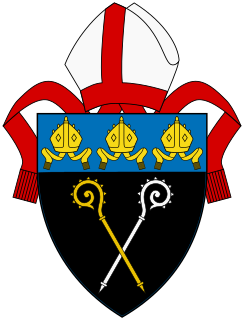Related Research Articles
Thomas Langton was chaplain to King Edward IV, before becoming successively Bishop of St David's, Bishop of Salisbury, Bishop of Winchester, and Archbishop-elect of Canterbury.

The Bishop of Llandaff is the ordinary of the Church in Wales Diocese of Llandaff.
Alexander Neville was a late medieval prelate who served as Archbishop of York from 1374 to 1388.
Robert Waldby was a native of York and friar of the Order of Saint Augustine who followed Edward, the Black Prince into Aquitaine. After studying at Toulouse, he became professor of theology there.

Lawrence Booth served as Prince-Bishop of Durham and Lord Chancellor of England, before being appointed Archbishop of York.

The Archbishop of York is a senior bishop in the Church of England, second only to the archbishop of Canterbury. The archbishop is the diocesan bishop of the Diocese of York and the metropolitan bishop of the Province of York, which covers the northern regions of England as well as the Isle of Man. The archbishop of York is an ex officio member of the House of Lords and is styled Primate of England; the archbishop of Canterbury is the "Primate of All England".

The Bishop of Worcester is the head of the Church of England Diocese of Worcester in the Province of Canterbury, England.

The Bishop of Rochester is the ordinary of the Church of England Diocese of Rochester in the Province of Canterbury.

The Bishop of Winchester is the diocesan bishop of the Diocese of Winchester in the Church of England. The bishop's seat (cathedra) is at Winchester Cathedral in Hampshire. The Bishop of Winchester holds ex officio the office of Prelate of the Most Noble Order of the Garter since its foundation in 1348, and Bishops of Winchester often held the positions of Lord Treasurer and Lord Chancellor ex officio. During the Middle Ages, it was one of the wealthiest English sees, and its bishops have included a number of politically prominent Englishmen, notably the 9th century Saint Swithun and medieval magnates including William of Wykeham and Henry of Blois.

The Bishop of Ely is the ordinary of the Church of England Diocese of Ely in the Province of Canterbury. The diocese roughly covers the county of Cambridgeshire, together with a section of north-west Norfolk and has its episcopal see in the City of Ely, Cambridgeshire, where the seat is located at the Cathedral Church of the Holy Trinity. The current bishop is Stephen Conway, who signs +Stephen Elien:. The diocesan bishops resided at the Bishop's Palace, Ely until 1941; they now reside in Bishop's House, the former cathedral deanery. Conway became Bishop of Ely in 2010, translated from the Diocese of Salisbury where he was Bishop suffragan of Ramsbury.
The Dean of York is the member of the clergy who is responsible for the running of the York Minster cathedral. As well as being the head of the cathedral church of the diocese and the metropolitical church of the province, the Dean of York holds preeminence as the Vicar of the Northern Province.
Nicholas Bubwith (1355-1424) was a Bishop of London, Bishop of Salisbury and Bishop of Bath and Wells as well as Lord Privy Seal and Lord High Treasurer of England.
Reginald Boulers was a medieval Abbot of Gloucester, Bishop of Hereford and Bishop of Coventry and Lichfield.
Thomas Kempe was a medieval Bishop of London.
Thomas Barrett was a fifteenth-century Bishop of Annaghdown.
James Blakedon O.P., D.Th. was a medieval prelate who served as Bishop of Achonry from 1442 to 1453, then Bishop of Bangor from 1453 to 1464.

James Bowstead (1801–1843) was an Anglican clergyman who served in the Church of England as the Bishop of Sodor and Man (1838–1840) and Bishop of Lichfield (1840–1843).
Sir John Hotham, 9th Baronet, DD (1734–1795) was an English baronet and Anglican clergyman. He served in the Church of Ireland as the Bishop of Ossory from 1779 to 1782 and Bishop of Clogher from 1782 to 1795.
Charles Booth, D.C.L. was a sixteenth-century clergyman who served as the Bishop of Hereford from 1516 to 1535.
Roger Cradock, O.F.M was a bishop in the second half of the 14th Century.
References
- Fryde, E. B.; Greenway, D. E.; Porter, S.; Roy, I., eds. (1986). Handbook of British Chronology (3rd, reprinted 2003 ed.). Cambridge: Cambridge University Press. ISBN 0-521-56350-X.
- Jones, B. (1965). "Bishops of Llandaff". Fasti Ecclesiae Anglicanae 1300–1541. Volume 11: The Welsh Dioceses. British History Online.
- Jones, B. (1962). "Bishops of Worcester". Fasti Ecclesiae Anglicanae 1300–1541. Volume 4: Monastic Cathedrals (Southern Province). British History Online.
| Catholic Church titles | ||
|---|---|---|
| Preceded by Richard Northalis | Bishop of Ossory 1395–1398 | Succeeded by John Waltham |
| Preceded by John Burghill | Bishop of Llandaff 1398–1407 | Succeeded by John de la Zouche |
| Preceded by Richard Clifford | Bishop of Worcester 1407–1419 | Succeeded by Philip Morgan |
| | This article about an English bishop or archbishop is a stub. You can help Wikipedia by expanding it. |